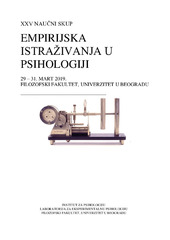| dc.description.abstract | Years of empirical work have shown that words with multiple related senses (polysemy) are
processed faster than unambiguous words, whereas the ones with multiple unrelated meanings
(homonymy) are processed slower (Rodd, Gaskell, & Marslen-Wilson, 2002). This was true
for the lexical decision task (LDT), however, if different experimental task was employed,
presence of those effects would vary. To account for this, Semantic Settling Dynamics (SSD)
model was developed (Armstrong & Plaut, 2016) which relies on the hypothesis that different
amounts of semantic demands between experimental tasks are the cause of varying effects.
Model predicts that polysemes produce a large effect in early phases that decreases with further
processing. In order to test this prediction further, we described polysemy by entropy – measure
that combines number of senses with the balance of their probabilities. In two experiments, we
used the same strategy of prolonging of the processing: we compared a visual LDT with its
slowed down version. In our first experiment, slowing down was attempted by reducing
stimulus-background contrast and in the second one, we compared visual and auditory LDT
(Armstrong & Plaut, 2016; Medeiros & Armstrong, 2017). First manipulation failed to prolong
processing, although expected facilitatory entropy effect was present in both experimental
conditions (high contrast: b = -.011, S.E. = .004, df = 220.4, t = -2.41, p = .017; reduced contrast:
b = -.012, S.E. = .003, df = 232.4, t = -2.748, p = .006). Second manipulation substantially
prolonged the processing and the interaction between entropy and the experimental
manipulation was significant (b = .022, S.E. = .003, df = 139.485, t = 8.039, p = .000). In visual
LDT, expected entropy effect was found (b = -024, S.E. = .020, df = 142.885, t = 30.425,
p = .000), while in the auditory LDT (prolonged), there was no such effect (b = -.003,
S.E. = .005, df = 166.99, t = -.589, p = .557).
Both results are in the accordance with model predictions – when there was no prolonging of
the processing, there was no change in entropy effect, while in the prolonged condition the
effect disappeared. According to model background, auditory lexical decision should still
produce polysemy effect, while in our experiment no effect was noted in that condition. These
results implicate that SSD model may predict modulation of the entropy effect, however, it is
unable to predict the exact effect change which is a great limitation of its predictive power. | sr |

